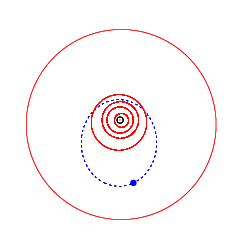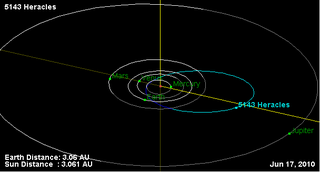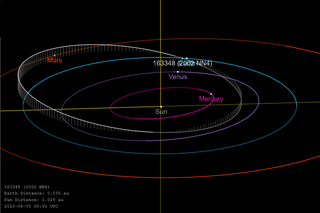Related Research Articles

9950 ESA, provisional designation 1990 VB, is an eccentric asteroid and elongated near-Earth object of the Amor group, approximately 1.7 kilometers in diameter. It was discovered on 8 November 1990, by French astronomer Christian Pollas at the Centre de recherches en géodynamique et astrométrie (Cerga) at Caussols in southeastern France. It was named for the European Space Agency (ESA).
4401 Aditi is an eccentric, stony asteroid, classified as a near-Earth object and Amor asteroid, approximately 1.8 kilometers in diameter. It was discovered on 14 October 1985 by American astronomer Carolyn Shoemaker at Palomar Observatory in California, and later named after the Hindu goddess Aditi.
1864 Daedalus, provisional designation 1971 FA, is a stony asteroid and near-Earth object of the Apollo group, approximately 3 kilometers in diameter. It was discovered on 24 March 1971, by Dutch–American astronomer Tom Gehrels at Palomar Observatory, California, and named after Daedalus from Greek mythology.

5143 Heracles(provisional designation 1991 VL) is a highly eccentric, rare-type asteroid and synchronous binary system, classified as near-Earth object of the Apollo group, approximately 4.8 kilometers in diameter. The asteroid was discovered on 7 November 1991, by American astronomer Carolyn Shoemaker at Palomar Observatory in California, United States. It is named for the Greek divine hero Heracles. It has an Earth minimum orbit intersection distance of 0.058 AU (8.7 million km) and is associated with the Beta Taurids daytime meteor shower.
3800 Karayusuf, provisional designation 1984 AB, is a Mars-crossing asteroid and suspected binary system from inside the asteroid belt, approximately 2.5 kilometers in diameter. It was discovered on 4 January 1984, by American astronomer Eleanor Helin at the Palomar Observatory in California. The S/L-type asteroid has a short rotation period of 2.2 hours. It was named after Syrian physician Alford Karayusuf, a friend of the discoverer.
4868 Knushevia, provisional designation 1989 UN2, is a bright Hungaria asteroid and suspected binary system from the innermost regions of the asteroid belt, approximately 2 kilometers in diameter. It was discovered on 27 October 1989, by American astronomer Eleanor Helin at the Palomar Observatory in California, United States. The asteroid was named for the Kyiv University in Ukraine.
4055 Magellan, provisional designation 1985 DO2, is a bright asteroid and near-Earth object of the Amor group. It is approximately 2.5 kilometers in diameter, and its orbit is moderately eccentric. It was discovered on 24 February 1985, by American astronomer Eleanor Helin at Palomar Observatory in California, United States. It was later named for Portuguese explorer Ferdinand Magellan.
2895 Memnon is a dark Jupiter trojan from the Trojan camp, approximately 56 kilometers in diameter. It was discovered on 10 January 1981, by American astronomer Norman Thomas at Lowell's Anderson Mesa Station near Flagstaff, Arizona, in the United States. The assumed C-type asteroid has a rotation period of 7.5 hours and belongs to the 80 largest Jupiter trojans. It was named after King Memnon from Greek mythology.
9165 Raup, provisional designation 1987 SJ3, is a stony Hungaria asteroid and exceptionally slow rotator from the inner regions of the asteroid belt, approximately 4.7 kilometers in diameter.

4765 Wasserburg (prov. designation: 1986 JN1) is a bright Hungaria asteroid, suspected binary system and asteroid pair from the innermost regions of the asteroid belt, approximately 3 kilometers (1.9 miles) in diameter. It was discovered on 5 May 1986, by American astronomer Carolyn Shoemaker at Palomar Observatory, and later named after geologist Gerald J. Wasserburg.
20936 Nemrut Dagi is a stony Hungaria asteroid and Mars-grazer from the innermost regions of the asteroid belt, approximately 3.5 kilometers in diameter. It was discovered on 13 May 1971, by Dutch astronomer couple Ingrid and Cornelis van Houten at Leiden, on photographic plates taken by Dutch–American astronomer Tom Gehrels at Palomar Observatory in California, United States. The asteroid has a rotation period of 3.28 hours, a likely spheroidal shape, and a high albedo typically seen among the enstatite-rich E-type asteroids. In 2012, it was named after the a dormant volcano Nemrut in Turkey.

(190166) 2005 UP156 is a stony asteroid and binary system, classified as near-Earth object of the Apollo group, approximately 1 kilometer in diameter. It was discovered on 31 October 2005, by astronomers of the Spacewatch survey at the Kitt Peak National Observatory in Arizona, United States. Its minor-planet moon with an orbital period of 40.25 hours was discovered in 2017.
(90075) 2002 VU94 (provisional designation 2002 VU94) is an asteroid on an eccentric orbit, classified as near-Earth object and potentially hazardous asteroid of the Apollo group, approximately 2.5 kilometers in diameter. It was discovered on 13 November 2002, by astronomers of the Near-Earth Asteroid Tracking program at Palomar Observatory in California, United States. It is one of the largest potentially hazardous asteroids known.
(159857) 2004 LJ1, provisional designation 2004 LJ1, is an asteroid on an eccentric orbit, classified as near-Earth object and potentially hazardous asteroid of the Apollo group, approximately 3 kilometers in diameter. The asteroid was discovered on 10 June 2004, by astronomers of the LINEAR program at Lincoln Laboratory's Experimental Test Site near Socorro, New Mexico, in the United States. It is one of the largest potentially hazardous asteroids known to exist.
(85713) 1998 SS49 (provisional designation 1998 SS49) is an asteroid on an eccentric orbit, classified as near-Earth object and potentially hazardous asteroid of the Apollo group, approximately 3 kilometers (1.9 miles) in diameter. The asteroid was discovered on 29 September 1998, by astronomers of the LINEAR program at Lincoln Laboratory's Experimental Test Site near Socorro, New Mexico, in the United States. It is one of the largest potentially hazardous asteroids and has a notably low Earth-MOID of less than the distance to the Moon.
(163243) 2002 FB3, provisional designation 2002 FB3, is a stony asteroid on an eccentric orbit, classified as near-Earth object and potentially hazardous asteroid of the Athen group, approximately 1.6 kilometers (1 mile) in diameter. It was discovered on 18 March 2002, by astronomers with the Lincoln Near-Earth Asteroid Research at the Lincoln Laboratory's Experimental Test Site near Socorro, New Mexico, in the United States. The Q-type asteroid has a rotation period of 6.2 hours.
(385343) 2002 LV, provisional designation 2002 LV, is a stony asteroid on a highly eccentric orbit, classified as near-Earth object and potentially hazardous asteroid of the Apollo group, approximately 1.5 kilometers in diameter. It was discovered on 1 June 2002, by astronomers with the Lincoln Near-Earth Asteroid Research at the Lincoln Laboratory's Experimental Test Site near Socorro, New Mexico, in the United States. The Sr-type asteroid has a rotation period of 6.2 hours and is likely elongated.
(21601) 1998 XO89 (provisional designation 1998 XO89) is a Jupiter trojan from the Greek camp, approximately 55 kilometers (34 miles) in diameter. It was discovered on 15 December 1998, by astronomers with the Lincoln Near-Earth Asteroid Research at the Lincoln Lab's ETS near Socorro, New Mexico. The dark Jovian asteroid has a rotation period of 12.7 hours and belongs to the 80 largest Jupiter trojans. It has not been named since its numbering in February 2001.
(15502) 1999 NV27 (provisional designation 1999 NV27) is a Jupiter trojan from the Trojan camp, approximately 53 kilometers (33 miles) in diameter. It was discovered on 14 July 1999, by astronomers with the Lincoln Near-Earth Asteroid Research at the Lincoln Lab's ETS near Socorro, New Mexico, in the United States. The dark Jovian asteroid has a rotation period of 15.1 hours and belongs to the 90 largest Jupiter trojans. It has not been named since its numbering in June 2000.

(163348) 2002 NN4 (prov. designation:2002 NN4) is a dark, sub-kilometer near-Earth object and potentially hazardous asteroid of the Aten group that flew by Earth on 6 June 2020. The highly elongated X-type asteroid has a rotation period of 14.5 hours and measures approximately 0.7 kilometers (0.4 miles) in diameter. It was discovered by LINEAR at the Lincoln Laboratory's Experimental Test Site in New Mexico on 9 July 2002.
References
- 1 2 3 4 5 6 7 8 9 "JPL Small-Body Database Browser: 12538 (1998 OH)" (2017-09-26 last obs.). Jet Propulsion Laboratory. Retrieved 31 October 2017.
- 1 2 3 4 "12538 (1998 OH)". Minor Planet Center. Retrieved 31 October 2017.
- 1 2 3 Mainzer, A.; Grav, T.; Bauer, J.; Masiero, J.; McMillan, R. S.; Cutri, R. M.; et al. (December 2011). "NEOWISE Observations of Near-Earth Objects: Preliminary Results". The Astrophysical Journal. 743 (2): 17. arXiv: 1109.6400 . Bibcode:2011ApJ...743..156M. doi:10.1088/0004-637X/743/2/156.
- 1 2 3 4 Mainzer, A.; Grav, T.; Masiero, J.; Hand, E.; Bauer, J.; Tholen, D.; et al. (November 2011). "NEOWISE Studies of Spectrophotometrically Classified Asteroids: Preliminary Results". The Astrophysical Journal. 741 (2): 25. arXiv: 1109.6407 . Bibcode:2011ApJ...741...90M. doi:10.1088/0004-637X/741/2/90.
- 1 2 3 4 5 6 7 "LCDB Data for (12538)". Asteroid Lightcurve Database (LCDB). Retrieved 31 October 2017.
- 1 2 3 Vaduvescu, O.; Macias, A. Aznar; Tudor, V.; Predatu, M.; Galád, A.; Gajdos, S.; et al. (August 2017). "The EURONEAR Lightcurve Survey of Near Earth Asteroids". Earth. 120 (2): 41–100. Bibcode:2017EM&P..120...41V. doi:10.1007/s11038-017-9506-9. hdl: 10316/80202 .
- 1 2 Lozano, Juan; Flores, Angel; Mas, Vicente; Fornas, Gonzalo; Rodrigo, Onofre; Brines, Pedro; et al. (April 2017). "Seven Near-Earth Asteroids at Asteroids Observers (OBAS) - MPPD: 2016 June-November". The Minor Planet Bulletin. 44 (2): 108–111. Bibcode:2017MPBu...44..108L. ISSN 1052-8091.
- 1 2 Warner, Brian D. (April 2017). "Near-Earth Asteroid Lightcurve Analysis at CS3-Palmer Divide Station: 2016 October-December". The Minor Planet Bulletin. 44 (2): 98–107. Bibcode:2017MPBu...44...98W. ISSN 1052-8091.
- 1 2 Warner, Brian D. (April 2015). "Near-Earth Asteroid Lightcurve Analysis at CS3-Palmer Divide Station: 2014 October-December". The Minor Planet Bulletin. 42 (2): 115–127. Bibcode:2015MPBu...42..115W. ISSN 1052-8091.
- ↑ "MPC/MPO/MPS Archive". Minor Planet Center. Retrieved 24 February 2018.